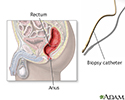Rectal biopsy
Biopsy - rectum; Rectal bleeding - biopsy; Rectal polyps - biopsy; Amyloidosis - rectal biopsy; Crohn disease - rectal biopsy; Colorectal cancer - biopsy; Hirschsprung disease - rectal biopsy
A rectal biopsy is a procedure to remove a small piece of tissue from the rectum for examination.
How the Test is Performed
A rectal biopsy is usually part of anoscopy or sigmoidoscopy . These are procedures to view inside the rectum.
Anoscopy
Anoscopy is a method to look at the: AnusAnal canalLower rectum

Sigmoidoscopy
Sigmoidoscopy is a procedure used to see inside the sigmoid colon and rectum. The sigmoid colon is the area of the large intestine nearest to the re...

A digital rectal exam is done first. Then, a lubricated instrument (anoscope or proctoscope) is placed into the rectum. You will feel some discomfort when this is done.
Digital rectal exam
A digital rectal exam is an examination of the lower rectum. The health care provider uses a gloved, lubricated finger to check for any abnormal fin...

A biopsy can be taken through any of these instruments.
Biopsy
A biopsy is the removal of a small piece of tissue for laboratory examination.
How to Prepare for the Test
You may get a laxative, enema, or other preparation before the biopsy so that you can completely empty your bowel. This will allow the doctor a clear view of the rectum.
How the Test will Feel
There will be some discomfort during the procedure. You may feel like you need to have a bowel movement. You may feel cramping or mild discomfort as the instrument is placed into the rectal area. You may feel a pinch when a biopsy is taken.
Why the Test is Performed
A rectal biopsy is used to determine the cause of abnormal growths found during anoscopy, sigmoidoscopy, or other tests. It can also be used to confirm the diagnosis of amyloidosis .
Amyloidosis
Primary amyloidosis is a disorder in which abnormal proteins build up in tissues and organs. Clumps of the abnormal proteins are called amyloid depo...

Normal Results
The anus and rectum appear normal in size, color, and shape. There should be no evidence of:
- Bleeding
- Polyps
-
Hemorrhoids
Hemorrhoids
Hemorrhoids are swollen veins in the anus or lower part of the rectum.
 ImageRead Article Now Book Mark Article
ImageRead Article Now Book Mark Article - Other abnormalities
No problems are seen when the biopsy tissue is examined under a microscope.
What Abnormal Results Mean
This test is a common way to determine the specific causes of abnormal conditions of the rectum, such as:
-
Abscesses
Abscesses
An abscess is a collection of pus in any part of the body. In most cases, the area around an abscess is swollen and inflamed.
Read Article Now Book Mark Article -
Colorectal polyps
Colorectal polyps
A colorectal polyp is a growth on the lining of the colon or rectum.
 ImageRead Article Now Book Mark Article
ImageRead Article Now Book Mark Article - Infection
- Inflammation
- Tumors
- Amyloidosis
-
Crohn disease
Crohn disease
Crohn disease is a disease where parts of the digestive tract become inflamed. It most often involves the lower end of the small intestine and the be...
 ImageRead Article Now Book Mark Article
ImageRead Article Now Book Mark Article -
Hirschsprung disease
in infants
Hirschsprung disease
Hirschsprung disease is a blockage of the large intestine. It occurs due to poor muscle movement in the bowel. It is a congenital condition, which ...
Read Article Now Book Mark Article -
Ulcerative colitis
Ulcerative colitis
Ulcerative colitis is a condition in which the lining of the large intestine (colon) and rectum become inflamed. It is a form of inflammatory bowel ...
 ImageRead Article Now Book Mark Article
ImageRead Article Now Book Mark Article
Risks
Risks of a rectal biopsy include bleeding and tearing.
References
Weinstein WM. Tissue sampling, specimen handling, and chromoendoscopy. In: Ginsberg GG, Gostout CJ, Kochman ML, Norton ID, eds. Clinical Gastrointestinal Endoscopy . 2nd ed. Philadelphia, PA: Elsevier Saunders; 2012:chap 5.
-
Anal biopsy - illustration
Rectal biopsy can be used to determine the cause of blood, mucus, or pus in the stool. Rectal biopsy can also confirm findings of another test or x-rays, or take a biopsy of a growth found in the colon.
Anal biopsy
illustration
Review Date: 9/17/2016
Reviewed By: Debra G. Wechter, MD, FACS, general surgery practice specializing in breast cancer, Virginia Mason Medical Center, Seattle, WA. Also reviewed by David Zieve, MD, MHA, Isla Ogilvie, PhD, and the A.D.A.M. Editorial team.

